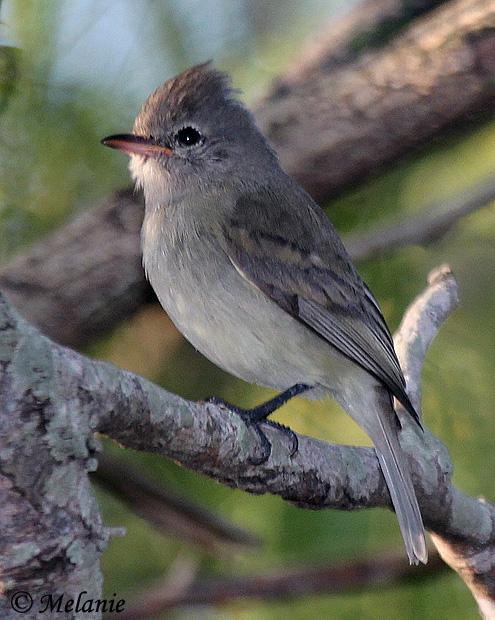| Length: 4.5 inches | Wingspan: 7 inches | Seasonality: Non-resident in South Dakota |
| ID Keys: Very small, gray upperparts, bushy crest, lighter underparts, short blunt bill | ||
 The
Northern Beardless-Tyrannulet is a very small flycatcher (the smallest in
North America) of Mexico and Central America, with a range that just reaches
the United States in southern Arizona and New Mexico, and the southern tip
of Texas. It gets its name because unlike many flycatchers, it lacks
specialized bristles around the mouth that help to capture flying insects.
Perhaps because of the lack of these bristles, the Northern
Beardless-Tyrannulet may focus more on slower, more easily captured insects
than do other flycatcher species.
The
Northern Beardless-Tyrannulet is a very small flycatcher (the smallest in
North America) of Mexico and Central America, with a range that just reaches
the United States in southern Arizona and New Mexico, and the southern tip
of Texas. It gets its name because unlike many flycatchers, it lacks
specialized bristles around the mouth that help to capture flying insects.
Perhaps because of the lack of these bristles, the Northern
Beardless-Tyrannulet may focus more on slower, more easily captured insects
than do other flycatcher species.
Habitat: Found in semi-open woodlands throughout its range. In the United States, it favors riparian areas with cottonwoods and willows, or mesquite stands, in its Arizona range. In Texas, it is mostly found in open woodlands, including mesquite stands.
Diet: Feeds on insects and spiders, and may on occasion feed on berries and seeds.
Behavior: Foraging by observing from a perch, and flying out to capture insects in mid-air, or by briefly hovering and gleaning insects from foliage and branches of vegetation. It will also clamber through branches of shrubs or trees in search of insects.
Nesting: The nest of a Northern Beardless-Tyrannulet is a small, rounded mass of grasses and weeds, with an entrance hole on the side. The female usually lays 3 eggs. Both parents help to feed the young when they hatch.
Song: The song of a Northern Beardless-Tyrannulet is a descending series of clear whistles.
Migration: Considered a permanent resident throughout most of its more tropical range, in the United States it is mostly migratory, although small numbers may remain in winter in southern Arizona and Texas.
Interactive eBird map: Click here to access an interactive eBird map of Northern Beardless Tyrannulet sightings
Similar Species: Somewhat similar to other small, gray flycatchers, such as Dusky Flycatcher, Willow Flycatcher, Hammond's Flycatcher, and Gray Flycatcher.
Conservation Status: Populations are found over a wide geographic area, they are common in parts of their range, and numbers may be increasing. The IUCN lists the Northern Beardless-Tyrannulet as a species of "Least Concern".
Further Information: 1) BirdLife International - Northern Beardless-Tyrannulet
2) WhatBird - Northern Beardless-Tyrannulet
3) Texas Breeding Bird Atlas - Northern Beardless-Tyrannulet
Photo Information: Photo taken by "Melanie" - Photo licensed under Creative Commons Attribution ShareAlike 2.0 Generic License.
| Click below for a higher-resolution map |
 |
| South Dakota Status: Non-resident in South Dakota |
Additional Northern Beardless-Tyrannulet Photos (coming soon!!)
